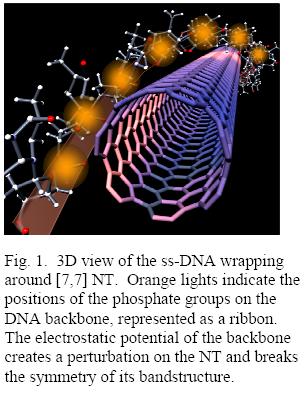

46870-G10
Theoretical Investigation of Ionomeric Polymer-Nanotube Composites as Novel Materials for Solar Engergy Applications
General Outline:
Our research focuses on fundamental materials science of the novel polymer-composite
materials based on nanotubes (NT). In year 2008, we performed modeling of the
electronic and optical properties of the hybrid complexes of NTs with the single-stranded
DNA (ss-DNA) which revealed the nature of one-electron transitions for different wrap
geometries and different polarization of the incident light. This study is necessarily to
understand mechanisms for the light absorption and the photo-voltaic effect, making NTbased
materials promising for solar energy applications.
Our major finding is a symmetry breaking induced in the NT by a helical wrap of the ss- DNA. Even though such effect may be expected following a general physics argument, it was never reported in the past. Based on our theoretical conclusion we proposed a nondestructive method to characterize the samples and to determine the wrap by analyzing the optical response in the cross-polarization [Snyder and Rotkin, Small, 2008]. This new theory supported by ACS-PRF generated a few collaborations (at LANL and in Japan) to find an experimental confirmation of the effect.
 |  |
Theoretical research leveraged on complementary experimental study of interactions of NTs and various polymers (besides ss-DNA). We have built a special setup for photoelectric measurements of NT materials (Ms. Ignatova). Substantial analysis of a series of samples prepared using a number of different techniques was done using Atomic Force and Scanning Electron Microscopies and electrical transport characterization. The goal is to optimize deposition techniques with respect to sample morphology which is the first step towards experimental study of the polymer-NT interface.
 |  |
Supplementary Summer grants from ACS-PRF supported experimental activity on the project. Prof. Huang from Chemistry Department at Lafayette College, an undergraduate institution, worked at Lehigh during the Summer-08 on the chemistry of polymer coating for the NT photo-diode fabrication. She, and her student at Lafayette, studied four polymers that are substantially different in their backbone electrostatics as well as being solvable in different solvents. The goal was to find a combination of two polymers which will give a well defined hetero-interface and, at the same time, will provide the opposite type of NT electrostatic doping on two sides of the interface.
The great impact of ACS-PRF support was not only in obtaining scientifically very important results, but also in providing minority faculty from non-PhD granting institution a unique opportunity to establish new collaborations and conduct a top-level multidisciplinary research at the critical moment of her career. This research is going to continue. Mr. Garrett Wadsworth, undergraduate student from Physics Department at Lehigh, had Summer training in my lab through ACS-PRF SUMR program. He learned sample fabrication techniques, electrical characterization techniques and the methods of result analysis. However, the most important outcome of the training is that we were able to attract the student from the underrepresented group, deeply involve him in scientific research and orient for continuing education beyond the BS level.
This research resulted in 4 papers in 2007-08 (two in the high-rank journals) and 10 presentations, including three invited talks.
Detailed description:
We proposed that the NT-polymer interface may play the major role in the charge carrier extraction and light conversion in solar cells made of NT-based materials. We conducted both theoretical modeling of the ssDNA-NT hybrids and made first steps toward direct experimental studies of NT-polymer samples.
In theory, we developed a semi-empirical quantum-mechanical approach for the NT wrapped with the ssDNA molecule (see Fig.1). Withing second quantization formalism, using the tight-binding Hamiltonian with (a) the selfconsistent Coulomb operator for the electron-electron interactions on the NT and (b) the electrostatic energy operator for the interactions with the charged backbone of the polymer (ss-DNA, for example), we wrote a code for calculating the electronic structure (band structure) of the NT-polymer complexes. The input parameters of the modeling include the geometry of the complex obtained through Molecular Dynamic modeling and from the experimental data.
A variety of wrappings and a selection of NTs of different diameters have been studied. A general effect observed in our modeling is the slight shift of the absorption/emission line in parallel polarization of the photon with respect to NT axis and substantial changes in the perpendicular polarization. The former effect has been detected experimentally, while the latter one did not. The appearance of predicted peak/shoulder (see Fig.2) in the cross-polarized spectroscopy is a clear identification of the helical wrap of the DNA.
In experimentation, we worked on obtaining a protocol for fabrication of the NT photodiode with polymer coating that has a distinct and abrupt hetero-interface. NTs dispersed in dichloromethane as well as ss-DNA wrapped NTs from water solution were used together with the poly(ethyleneimine), poly(methylmethacrylate), poly(acryalic acid), and poly(acrylamide) coatings. Sample fabrication was followed by AFM and electrical transport characterization. Next we plan to perform photo-electric measurements for the samples produced using optimized protocols.